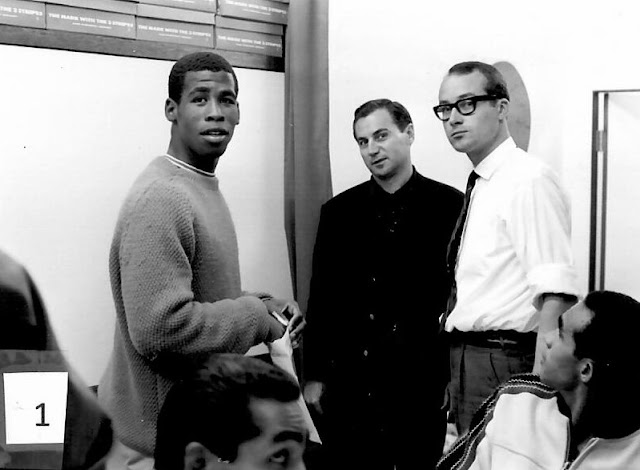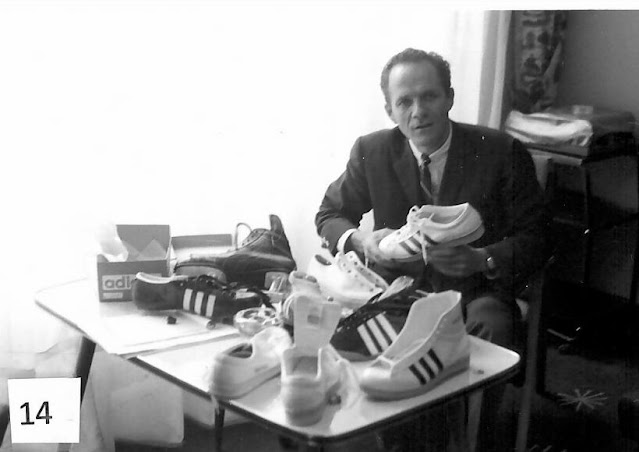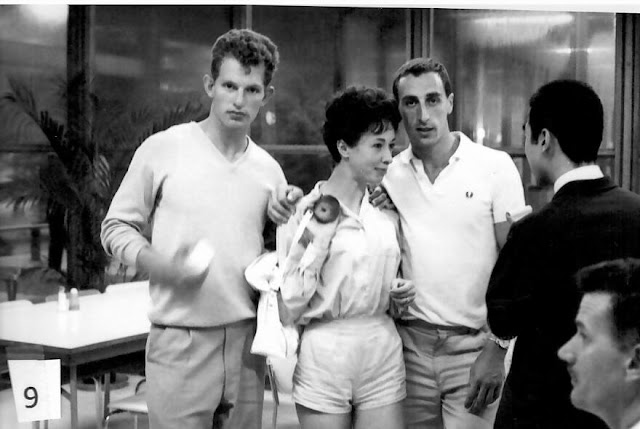I was privileged to attend two days, (Friday and Saturday June 28 and 29) of the US Olympic Trials in Eugene, Oregon. My good friend Jon Little invited me to go there with him from Vancouver Island, about a ten hour drive. We only left on Thursday afternoon, missed a ferry to the mainland and ended up driving til 2:00AM Friday morning. Then up and on the road by 9:00AM. Listened to five minutes of the Biden-Trump debate (as much as we could stand) before turning it off. Paralleling Uncle Joe's age I was beginning to understand how he must have felt on that stage across from a motor mouth. At least the US athletes are showing some progress if our politicos are not. God Bless America, We Need It.
Then a great time that evening watching Grant Holloway running that incredible 110HH (12.86) along with Freddie Crittenden (12.92) and Daniel Roberts (12.96) and the women's 10,000 meters on Saturday when Weini Kelati (31:41.07) on Parker Valby and Karissa Schweizer's (both 31:41.56) backs and showing them how to sprint down the last 100 meters. There were lots of exciting prelims as well including Bryce Hoppel's 1:42.77 800m. The near capacity crowd went crazy for all this. The constant cheering carried the athletes around the track every lap. When all was done, my only question was, "Now how will these kids do when the Kenyans, Ethiopians, English, Scots, Dutch, Tanzanians, Chinese, and all the rest of the world are on the track with them?" I think many will still need to find a couple of extra gears for the final quarter of their races. In their O Trials a 19 year old Kenyan Emmanuel Wanyoni, with rugby player thighs ran a 1:41.70, closely followed by Wyclife Kinyamai, 1:42.50, and Koitatoi Kidali 1:42.66. Hoppel will have to rely on his running savvy against this lot. Lest we forget Marco Arop just across our northern border who ran a 1:43.78 virtually alone on the track. But that is the test for everyone in their respective countries. They will soon all be together on the same equal playing field, and we will have the joy of witnessing those races and jumps, and throws.
It is hard to imagine a more intense period of sport around the world with the European soccer championships going simultaneously with the opening rounds of Wimbledon tennis, the COPA Cup in western hemisphere soccer, the Tour de France all drawing our attention and the Olympics on the near horizon. Might even consider some cricket and lawn bowling if you are of British heritage. Watching Stage 4 of the Tour yesterday, I saw Mark Cavendish win a record 35th stage in the Tour. I was amazed at these riders' bravery coming in at the end of a hundred mile ride, admittedly getting sucked along in the draft of their teammates most of the way, but still you have to do some pedalling. And this was coming the day after finishing a difficult Stage 3 at the top of a snow capped mountain. The lesson to be learned though was their amazing ability to avoid crashing (most of the time) while riding bunched up at 30-40 miles an hour with only a helmet for protection. Maybe middle distance runners could learn something from these guys and ladies about avoiding the collisions in a closely contested race as runners are breaking for the pole. I know this is a track and field blog but I'm putting a link to that finish on Stage 4 of the Tour. Watch, if you wish, how Cavendish comes out of the pack to win the stage. Cavendish Finish Stage 4 Good luck understanding the thick British accents of the commentators.
Finally a bit of history came to me about the Billy Mills victory at Tokyo in 1964. It is related in a piece written by Dick Bank who brought Billy's winning sprint to the line to everyone's attention. Had he not stepped in as a secondary commentator and spoke over Bud Palmer, many would have missed Billy's breasting the tape. For his audacity, Bank was fired. This is the back story in Dick's own words. I had the privilege of phoning Dick once to ask for an address of an athlete and was the recipient of one of his impromptu expostulations on track history. He asked me where I had run in college, and right away spouts the name of my long retired coach, Bill Carroll, then gives me the place Bill finished in the NCAA polevault, when he was in school and his clearance height to the fraction of an inch. I'll shut up now and let Dick Bank take over. I've added a few photos to fill in the story.
Dick BankFOR LUDDITES ONLY
“LOOK AT MILLS! LOOK AT MILLS!" THE TRUE STORY OF DICK BANK’S VERY BRIEF BUT NOTABLE
TELEVISION PARTICIPATION AT THE TOKYO OLYMPICS IN 1964—AS TOLD TO ARTHUR HEAD ESQ.
It has come to my attention that there are some postings about me on the Internet. I don't own a computer . . .
nor do I want or need one. Mine is between my ears.
I still type on an IBM Wheelwriter 1000, drive a 1989 Volvo 240GL with 299,000 miles, and do not have nor do I
need a cellular telephone; or one that can take photographs.
So you can well understand why I didn’t know there was something about me on the Internet.
I did know that the last lap was on YouTube, but not the personal comments. Billy has had a DVD made of it that he sells, and I have it. Also, a red T-shirt that says, “Look at Mills! Look at Mills!”
I would like to make known the correct facts relative to my participation on NBC's telecast of the Tokyo
Olympics. I was hired by Jim Kitchell, the executive producer, who was from NBC News. He had done presidential assassinations, space shots, etc., but he knew nothing about sports. I think my good friend, the late Bud Palmer, might have had a hand in it.
I had worked for ABC’s “Wide World of Sports” in 1962, did the US-USSR meet from Stanford that year, from Moscow the next year . . . and from Kiev in 1965. I was hired as an expert commentator. I wasn't an itinerant, as stated. Bud Palmer was one of the finest people I have ever met—not too many of his kind in that business—and the last thing I would have done was to embarrass or show him up. That summer, the first of two Olympic Trials were held on Randall’s Island in New York City (the Olympic Trials had been held there in 1936, but it had deteriorated badly over the years).
Bud PalmerBud asked where I was planning to stay when in New York. I told him I had no plans. He said he and his wife Daisy were going to be away at that time, and I was welcome to use their rather large apartment on Park Avenue. Which I did!
As the final two hundred meters of the race unfolded, Bud, for whatever reason, lost sight of Billy Mills. I could see that he was going to win the race and there was not going to be any mention of him until he had crossed the finish line. He was focusing on Clarke and Gammoudi. I didn’t grab Bud's microphone. I had my own. What went out over the air was not an attempt to fill in commentary. It was a natural reaction, as if I were a spectator. It just so happened there was dead air, so I was easily heard.
It has been written that I was giggling with glee. It was more like unrestrained euphoria that quickly became tears. My good friend Neil Allen of the London Times came up from his seat in the press section to offer congratulations. I could barely speak.
The next day, Kitchell said what I had done was "very unprofessional.” Dick Auerbach, the producer (he had no knowledge of track and field), told me they would be turning off my microphone during the final events. My response: “Then why bother to turn it on?” We did not have an enclosed announce position. I continued to sit there for the next few days, offering easily heard comments under my breath. Bill Henry was the third person. He was a grand, old gentleman, stadium announcer at the 1932 Los Angeles Olympics, but was no longer informed on the sport.
After the third day, I found a message when I returned to the Okura Hotel: call Dick Auerbach at the New Otani. He was having dinner on the top floor. I said it was Dick Bank, returning his call.
“I have some bad news for you.” My father had had a heart attack in April 1961, and was confined to our home. He was my first thought. Of course, there would have been a call from my mother. “From today on, you are no longer working for NBC.” My response: “So what's the bad news?” He was an oily guy who didn’t have the guts to tell it to my face.
I was never identified over the air. My dear, late friend Harley Tinkham, did identify me in the Los Angeles Mirror-News. Brutus Hamilton, the longtime coach at California and head coach at the Helsinki Olympics in 1952, said to his wife: “That could only be one person . . . it has to be Dick Bank.”
I was confined in that announce position. Now I could hob-nob with the European press . . . and I knew a lot of them, and speak out as I wished. When I returned home, NBC refused to pay me. My then brother-in-law was an attorney, associated with the infamous Marvin Mitchelson. Marv had been a close friend since our days at Los Angeles High School. A call was made to NBC in Burbank, advising them that if a check was not in their office by five that afternoon, an action would be taken. It was.
I later worked for CBS, doing thirty-five meets in 1969-70, calling the races and working alone. Ron Clarke, who passed away recently, was a dear friend. I had corresponded with him in 1956 when I was the high school editor of Track & Field News and he had broken the world junior one mile record. You can imagine my thrill—we had not yet met—when he came into the stadium carrying the torch at the Opening Ceremonies in Melbourne.
The sport was my passion in those years and I was privileged to know just about everybody who was anybody. I came along at just the right time. There isn’t a lot to like about the sport today. I do enjoy watching the major competitions, especially the Diamond League telecasts. The commentary is absolutely first rate, putting to shame that band of misfits NBC has the audacity to unleash on its viewers. I am a big fan of the women just like I love the UConn basketball team and the U.S. soccer team. They give it their very best, every time.
Gabril KorobkovI think my greatest compliment came from Gabril Korobkov, the chief coach of the Soviet track and field team. “You know more about my athletes than I do.” As a postscript, I should mention I also worked for adidas at that time, making sure the best American athletes were in the shoe with the three stripes. Not difficult: there was only Puma, no Nike yet. Puma made an inferior shoe, and could get some of the top athletes to wear it at the Olympics only by paying them. At that time, that sort of thing really did not exist. It came four years later at Mexico City. Adi Dassler, the shoe genius, developed a new model for both Melbourne and Rome; so, of course, he would have one for Tokyo. The shoe for Rome was the first with removable spikes.
To make the shoes as light as possible, the leather was tanned on the reverse (hide) side so that the upper could be glued. Eliminating the nails made them much lighter. They were a blue suede and fit like a glove. Adidas had a stand in the Olympic Village where the athletes came to get their “Tokyo.” It was very close quarters, narrow, and not much room for anything but the shoes.
I was working there, so all of the Americans were sent over to me. Also, there was the original adidas distributor, Cliff Severn, who was based in North Hollywood. He was as well-informed as Kitchell and Auerbach, very much in the way, and of no help whatsoever. When Billy came in, I was busy and asked him to wait. After I was finished, I said, “Where’s Billy? I was told he had left . . . without shoes. Severn had interceded, didn’t know who he was, and told him there were no shoes for him.
I charged out of there and saw Billy storming away. When I caught up to him, he was more than angry; he was furious! Of course, he got his shoes . . . size 12, if memory serves me correctly. He had been wearing Puma. I would have been absolutely mortified had he won in Puma. Well, it wouldn’t have happened. His feet would have been so badly blistered that he might not have even finished the race!
Ed. See any parallels in NBC today and NBC 1964?
Edwin Roberts at the Adidas stand in TokyoAlain Mimoun (FR) with Galloise in his hand Tokyo, 1964
Cliff Severn at Adidas France in December, 1964
Robbie Brightwell, Ann Packer and John Cooper (all GBR)
at Adidas booth Tokyo 1964
Story on these and other photos can be seen at link: Cliff Severn Rises from the Ashes











No comments:
Post a Comment